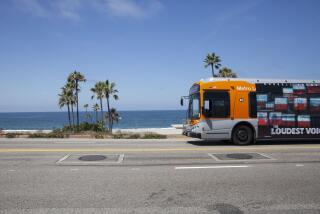Judging RTD’s Performance
- Share via
The Times article “RTD Critics Say It Could Learn From Big Blue Bus” (Part I, June 12), while provocative in raising issues, is seriously flawed. It is based on the faulty premise that RTD should be judged according to the same criteria as the Santa Monica bus company. Ultimately, the article misses the clear and overriding truth: RTD is not just improving. RTD is doing things right.
RTD and Santa Monica have significantly different missions. RTD has been established by law as the regional carrier. It is required to provide bus service in most county areas, regardless of the level of demand, number of passengers per bus, and cost of operation. RTD is mandated to provide service where it is needed, not where it is most operationally profitable.
A more thorough evaluation of Santa Monica’s bus service shows that Santa Monica concentrates its service primarily where it can acquire high fare-box revenue.
RTD, on the other hand, covers more than 2,000 square miles in more than 80 cities in greater Los Angeles. Obviously, it could not serve more than 1.5 million passengers a day and fulfill its mandate as the regional carrier if it cherry-picked its route and hours of operation to capture the highest fare-box revenue. RTD, because of its mission, simply does not have that luxury.
Also overlooked in the article was reference to the large high-crime areas of the county in which some RTD lines operate weekdays, nights and weekends. Santa Monica does not need a transit police force. We do, to safeguard our passengers and equipment on these lines.
Left unmentioned as well were administrative costs that RTD pays for but that the Santa Monica bus company shares with other city departments. RTD incurs substantial legal fees to cope with civil suits, many of them frivolous, and to insure that fraud is prosecuted. Santa Monica uses city legal counsel.
The article implies that the RTD be split into 10 bus companies to more closely match the size, and presumed economies, of the Santa Monica organization.
Separate companies might meet the localized needs of compact communities, but they could never efficiently serve millions of bus riders with a local and regional grid system that provides consistent access to thousands of schools, hospitals, malls and employment centers.
Other vital facts were omitted. RTD has shown steady improvement in key areas of its operations in the past year. Bus operator absenteeism has declined 5%. Total complaints per 1 million boardings has dropped 9% to 31.2. Traffic accidents have been reduced 4% to 4.4 per 100,000 miles.
Also, RTD has put forth a balanced budget. Spending has been cut. Positions were eliminated. And internal reorganization is being implemented that will reduce costs, build efficiency and improve bus maintenance.
At the same time, RTD has given high priority to building its ridership. In March, RTD buses carried 1.48 million boarding passengers on an average weekday. That’s a 9.6% increase from the previous March. April’s figure of 1.46 million passengers was up 4.5% from the same month last year. These statistics hardly reflect a poorly run transit organization!
Moreover, RTD is providing service within severe fiscal restraints forced by cuts at the federal and state levels. As a result, RTD has had to cut service when we need more buses on the street, not fewer.
In research surveys, our riders have always rated RTD service and operators highly, contrary to the selective interviews that appeared in the article. RTD has twice this year provided special competition and recognition for drivers’ courtesy and helpfulness with the bus-riding public. This program is in addition to long-standing programs that reward operators for driving skill and performance.
Again, The Times raised some interesting issues. But the facts, including those which were overlooked or misinterpreted in the article, show that RTD is hardly floundering. RTD is on track.
JAN HALL
RTD Board Member
More to Read
Sign up for Essential California
The most important California stories and recommendations in your inbox every morning.
You may occasionally receive promotional content from the Los Angeles Times.













